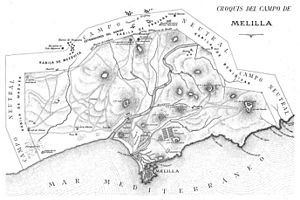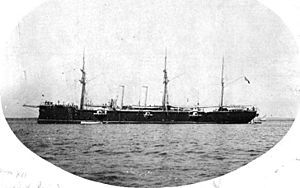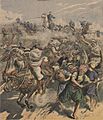First Melillan campaign facts for kids
Quick facts for kids First Melillan campaign |
|||||||||
|---|---|---|---|---|---|---|---|---|---|
| Part of the Spanish-Moroccan conflicts and Scramble for Africa | |||||||||
 War in Morocco, Death of the Spanish General Margallo, from Le Petit Journal, 13 November 1893. |
|||||||||
|
|||||||||
| Belligerents | |||||||||
|
|||||||||
| Commanders and leaders | |||||||||
| Strength | |||||||||
| 25,000 regulars and militia | 40,000 irregulars | ||||||||
The First Melillan Campaign was a conflict between Spain and some local tribes in northern Morocco. It is also known as the Melilla War or the Margallo War in Spain. This second name comes from Juan García y Margallo, who was the Spanish governor of Melilla. His defeat and death made the Spanish public very angry. The conflict began in October 1893 and officially started on November 9, 1893. It ended with the Treaty of Fez in 1894.
Contents
Why the Conflict Started
Castile took control of the city of Melilla in 1497. In the 1800s, Spain started to expand into the areas around Melilla. They also began to invest money in developing these lands.
Agreements with Morocco in 1859, 1860, and 1861 helped Spain gain more influence. Even though the Moroccan government agreed with Spain, there were often problems. Spanish Army patrols clashed with local Berber tribes. These tribes did not like Spain, and the Sultan of Morocco had little control over them.
Reports of raids and piracy by the Rif tribes were common in Spanish newspapers. In the early 1890s, the Rif captured a Spanish merchant ship. They also took its crew. A small rescue team found that the captives had been sold into slavery.
In the summer of 1893, the local tribes became more active. This allowed Governor García y Margallo to get money to build stronger defenses around Melilla. Construction moved very quickly. The main goal was to build new forts called redoubts at Peuta de Cabiza and Punta Dolossos.
The Siege of Melilla Begins

After a period of growing violence, the war truly began on October 3. About 6,000 Rif warriors attacked the city's small army of 400 soldiers. The Rif warriors were armed with Remington rifles.
The Spanish soldiers fought a difficult battle all day. They lost 21 men and had 100 wounded. The people living in Melilla ran to the main fortress for safety. Even though civilians helped defend the city, the large number of attackers forced the defenders to retreat into the fortress. More tribesmen from the hills joined the Rif warriors.
The Rif warriors did not have heavy weapons. They tried to capture the fortress by charging up the roads and climbing the walls. People watching said it was a brave but hopeless attack. The Spanish soldiers defended the walls with their bayonets and gunfire. They used their powerful 7 mm Mauser Model 1893 rifles for the first time. These rifles became famous later at the Battle of San Juan Hill.
Many Rif warriors died, about 160 of them. Spanish artillery was brought forward and used to bomb Rif groups in nearby villages. However, one unlucky cannonball destroyed a mosque outside the city. This made the Rif effort turn into a jihad, a holy war. Moroccans from all over the province, no matter what they thought before, joined the fight against Spain. By October 5, the native force had about 12,000 fighters. Some reports said there were as many as 20,000 foot soldiers and 5,000 cavalry.
The Crisis Grows
On October 4, the ironclad ship Numancia fired shells at several villages along the coast. An artillery group from Málaga arrived in Melilla that same day. For several weeks, the situation did not change much.
Juan García y Margallo, the Governor of Melilla, sent a warning to the Rif, but it did not work. The Sultan sent his own troops under Baja-el-Arbi to calm things down, but they also failed. Small fights happened at forts Camellos and San Lorenzo. When the Rif destroyed the forts they had captured, Margallo sent out small groups of soldiers and workers. They built new earthworks at forts Cabrerizas and Rostro Gordo, protected by Spanish cannons.
On October 22, the gunboat Conde de Venadito sailed to the mouth of the Río de Oro. It stopped there and fired its Hotchkiss guns at the Rif. The ship fired 31 shells at the Rif trenches. It then returned to Melilla's harbor without any damage.
On October 27, about 5,000 Rif warriors launched a strong attack on the heights of Sidi Guariach. Even though the Venadito and Spanish cannons fired at them, they pushed General Margallo and General Ortega back into the fortress. They also took control of the half-finished Spanish defenses.
Margallo's Last Attack
To remove the Rif warriors from the defenses near Cabrerizas and Rostro Gordo, Margallo led an attack. On October 28, he rode out with 2,000 men. There were about 3,000 Rif warriors in the trenches. Both sides fought bravely. The Rif warriors held their ground, and 6,000 more fighters joined the battle.
With more fighters, the Rif warriors tried to surround Margallo's Spanish soldiers. The general thought he saw a weak spot in the enemy's center. He led a charge against the Rifian trenches but was forced back with many losses.
Margallo ordered a retreat. He was shot and killed moments later, and his group fell apart. The Spanish Army said at least 70 men were killed and 122 wounded that day. The real losses were likely much higher. Only General Ortega's actions in the rear guard prevented the retreat from becoming a complete defeat.
News of this disaster, along with Ortega's telegrams, convinced the Spanish government to send more troops. They sent three cavalry regiments and four infantry battalions that day. The next morning, October 29, Ortega led 3,000 men out of Cabrerizas. They cleared the Rif warriors from their ruined trenches.
Among the soldiers who survived Margallo's last attack was a young Lieutenant named Miguel Primo de Rivera. Later army investigations showed that Margallo had made a lot of money by taking guns and supplies from the army and selling them to local people. It is thought that the Rif warriors might have shot him with the very weapons he had sold them.
A Difficult Stand-Off

By early November, the Spanish soldiers in Melilla were fighting hard to survive. Large Rif forces controlled the beaches. This made it difficult for the Spanish Navy to bring in horses, soldiers, and supplies. The Rif expanded their trenches around the city and set up strong camps. They blocked all communication between the main fortress and the smaller forts. They also destroyed the roads between them.
Only brave night attacks by the Spanish kept the smaller forts supplied with water, food, and ammunition. Still, the defenders held on. Heavy fire from the fortress stopped Rif advances and kept the town safe from invaders.
Spanish actions were sometimes very harsh. Prisoners and forced laborers were put into special groups. These groups were led by army officers. They would sneak out at night to ambush Rif patrols. These units scared the Rif warriors and also caught the attention of foreign newspapers. People were amazed by their courage and their brutal methods.
Work continued without stopping at the various forts. The defenders had plenty of building materials, engineers, and workers. They managed to keep building their defenses even while under attack. Spain lost 12 officers and 100 men during the month. Rif losses were estimated at 500 dead, mostly from the bombardments.
Help Arrives and Peace is Made

When the armoured cruisers Alfonso XII and Isla de Luzon arrived, Spain began to use its naval power fully. They constantly bombed the Rif from the coast. On November 6, Spain's naval guns forced the Rif, who were badly hit, to ask for talks. When the Rif were not willing to surrender, these cannon attacks were repeated every night. This was the first time searchlights were used on a battlefield.
Back in Spain, the military, which had been slow at times, became very active after Margallo's defeats. By the middle of November, General Macias, who took over from Margallo, received enough forces. These forces helped keep the Rif in check and rebuild Melilla's outer defenses.
General Martínez-Campos sailed to Melilla on November 27 with 7,000 more soldiers. This brought the total number of men fighting in the war to two Army Corps. In April 1894, Martínez de Campos became both the military commander and the Ambassador to Morocco. He then negotiated peace directly with the Sultan.
What Happened Next
Other European powers watched Spain's campaigns against the Rif very closely. France wanted an ally for its own plans in the region. So, France encouraged Spanish territorial expansion at Morocco's expense.
However, Spain was not very interested in having a large African empire. Spain was also careful not to break agreements with the United Kingdom. The UK worried about any country taking land near the Straits of Gibraltar. Because of this, Spain only asked for small land changes from the Sultan. This did not stop France's ambitions. In 1912, the Treaty of Fez divided Morocco into French and Spanish protectorates.
As a result of the war, Melilla received its own branch of the Guardia Civil, which is Spain's police force.
See also
 In Spanish: Guerra de Margallo para niños
In Spanish: Guerra de Margallo para niños
- Tetuán War
- Second Melillan campaign
- Kert campaign
Images for kids









